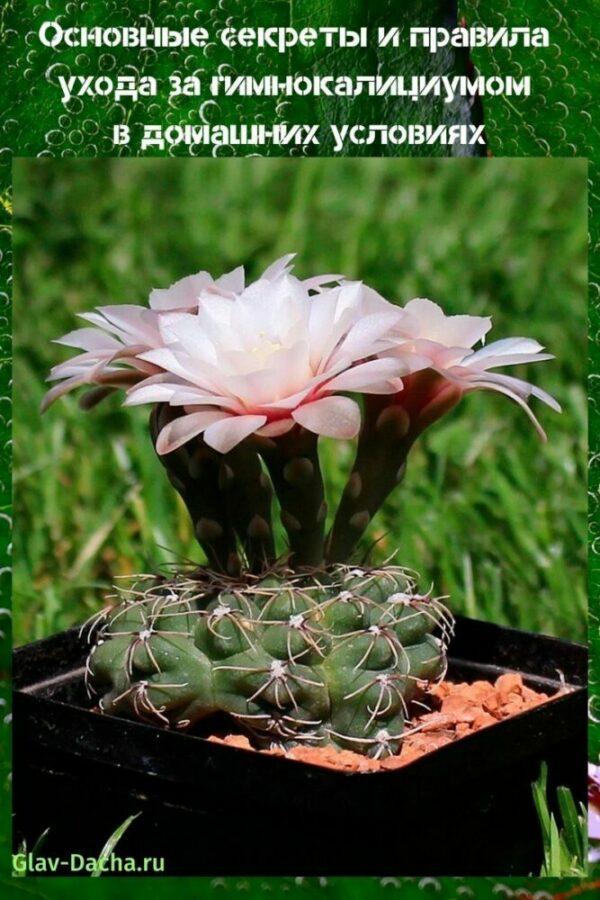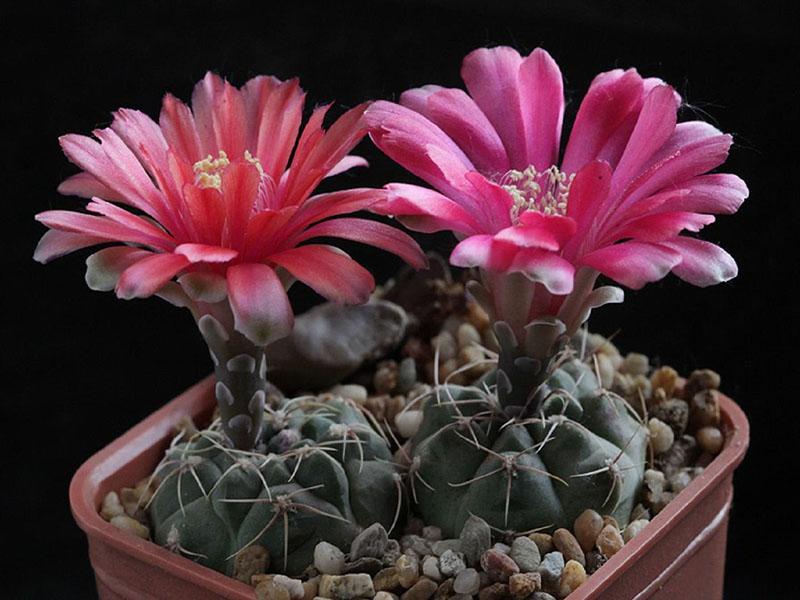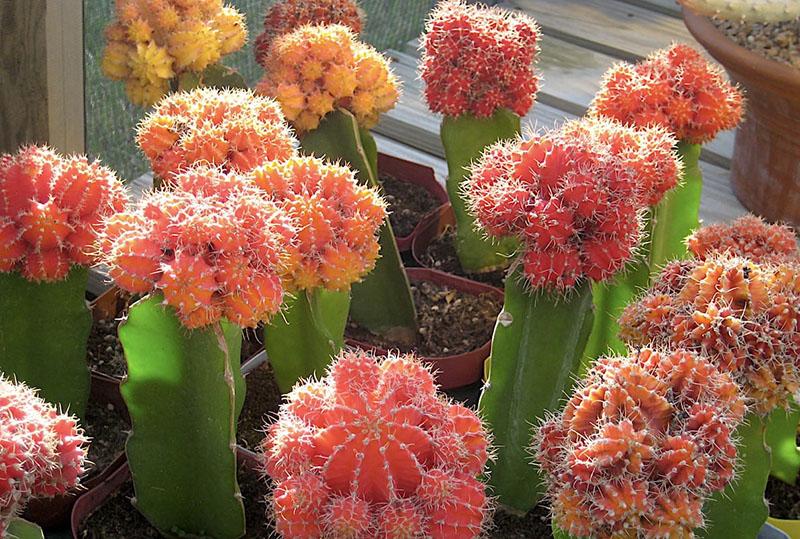The main secrets and rules for caring for the gymnocalycium at home
 Gymnocalycium is one of the most popular and beautiful cacti native to South America. Caring for a hymnocalycium at home is very simple while creating comfortable conditions for growing a plant.
Gymnocalycium is one of the most popular and beautiful cacti native to South America. Caring for a hymnocalycium at home is very simple while creating comfortable conditions for growing a plant.
Popular varieties of hymnocalycium

Popular types for growing at home:
- Gymnokalycium Mikhanovich is the most common variety with flattened stems up to 4-6 cm high. The plant has 9-10 ribs with a wavy, pointed edge, flowers of a yellow or red hue. Among the ways how to graft Mikhanovich's hymnocalycium, grafting on green varieties is most often chosen.

- Reductum is the largest representative of the species. An adult plant can reach 50-60 cm. As it grows, the color and shape of the stem change, the cactus becomes oval from round.

- Friedrich's Gymnocalycium is a hybrid species created in Japan. Has an extraordinary color, which changes from purple to red and yellow.

- Horsta is a variety of low cacti, reaching 15-25 cm in height. The stem is dark green, in the form of a flattened ball. Flowers are cream, lilac or pink.

- Aqua Dulce is a miniature plant with a short but strong stem, occasionally covered with small thorns.

When caring for a gymnasium at home, it is imperative to take into account its variety, since they differ significantly in terms of growing conditions.
Gymnocalycium care at home
 Growing a cactus is easy and simple. When caring for the hymnocalycium at home, you need to provide the plant with a comfortable temperature regime and lighting, do not forget about watering, feeding and timely pruning.
Growing a cactus is easy and simple. When caring for the hymnocalycium at home, you need to provide the plant with a comfortable temperature regime and lighting, do not forget about watering, feeding and timely pruning.
Temperature control and lighting
 Gymnocalycium is unpretentious to temperature conditions. The optimum temperature for growing a plant is from + 15 ° C to + 25 ° C. The basic rule of caring for a cactus is the absence of drafts and sudden temperature changes, which it cannot tolerate.
Gymnocalycium is unpretentious to temperature conditions. The optimum temperature for growing a plant is from + 15 ° C to + 25 ° C. The basic rule of caring for a cactus is the absence of drafts and sudden temperature changes, which it cannot tolerate.
 When caring for a cactus with hymnocalycium, it must be borne in mind that it belongs to light-loving plants. Despite this, the plant should not be placed in direct sunlight, especially on hot days. This could burn the stem.
When caring for a cactus with hymnocalycium, it must be borne in mind that it belongs to light-loving plants. Despite this, the plant should not be placed in direct sunlight, especially on hot days. This could burn the stem.
In winter, the cactus will need additional artificial lightingas it may lack sunlight.
Watering
 Gymnokalimtium does not need frequent watering. It needs to be moistened only when the soil in the flower pot dries well between March and late October, after which the plant goes into hibernation.
Gymnokalimtium does not need frequent watering. It needs to be moistened only when the soil in the flower pot dries well between March and late October, after which the plant goes into hibernation.
 For watering a cactus, only settled liquid is used with the addition of a small amount of citric acid or vinegar - this will soften hard water. Summer moisture should be slightly more abundant than autumn moisture.
For watering a cactus, only settled liquid is used with the addition of a small amount of citric acid or vinegar - this will soften hard water. Summer moisture should be slightly more abundant than autumn moisture.
In winter, the hymnocalycium does not need to be watered.
The stem of the hymnocalycium cactus should never be irrigated. Spraying the aerial part of the plant often causes its decay, so systematic watering is quite enough.
Soil and pot selection

Gymnocalycium has small roots, so it can be grown even in small flower pots up to 10 cm high. Its diameter should be slightly wider than the plant's root system. During the growth of the cactus, the pots should be changed to larger ones.
 For growing hymnocalycium at home, loose, permeable, slightly acidic soil is used. You can use a ready-made store substrate or prepare it yourself from turf, humus, peat and leafy soil with the addition of a small amount perlite and coarse sand.
For growing hymnocalycium at home, loose, permeable, slightly acidic soil is used. You can use a ready-made store substrate or prepare it yourself from turf, humus, peat and leafy soil with the addition of a small amount perlite and coarse sand.
A drainage layer must be laid on the bottom of the flower pot, and only on top of it is a ready-made or self-prepared substrate.
Top dressing
 Gymnocalycium needs systematic feeding. Fertilizers are applied every 10 days and only during the period of active plant growth. Top dressing usually starts in mid-March and lasts until October.
Gymnocalycium needs systematic feeding. Fertilizers are applied every 10 days and only during the period of active plant growth. Top dressing usually starts in mid-March and lasts until October.
For feeding the hymnocalycium, complex mineral fertilizers are used, intended for cacti and succulents. The composition of such preparations should include potassium, phosphorus and nitrogen - they stimulate flowering and plant growth.
Gymnocalycium transplant
 It is advisable to transplant Gymnocalycium in the period from March to April. All weak, rotten and weakened roots should be trimmed at the same time.
It is advisable to transplant Gymnocalycium in the period from March to April. All weak, rotten and weakened roots should be trimmed at the same time.
Cactus transplant algorithm:
- pour a layer of drainage from broken brick, expanded clay or shards to the bottom of the flower pot;
- pour a fertile substrate over the drainage layer;
- place the plant on the ground and straighten its roots;
- sprinkle the roots with fertile, pre-steamed soil;
- pour a layer of coarser soil mixed with fine gravel on top;
- sprinkle the surface of the substrate with steamed clean sand or gravel.
After transplanting, the hymnocalycium should be placed in a shaded area. You can water the plant only after 5-6 days.
 A young, fast growing plant needs to be replanted every year. An adult cactus slows down its growth, so the procedure is carried out much less often - once every 3-4 years.
A young, fast growing plant needs to be replanted every year. An adult cactus slows down its growth, so the procedure is carried out much less often - once every 3-4 years.
Reproduction of hymnocalycium
 Reproduction of hymnocalycium can be both vegetative and seed. The first type is considered more problematic, since most species of cacti rarely and take a long time to form shoots. It often takes at least 10 years for their education.
Reproduction of hymnocalycium can be both vegetative and seed. The first type is considered more problematic, since most species of cacti rarely and take a long time to form shoots. It often takes at least 10 years for their education.
 After the appearance of the shoot, it should be removed as soon as the size reaches 1-2 cm. Next, it must be placed on a moistened mixture consisting of a substrate for cacti and river sand. For rooting, the baby must be placed in a cool, well-lit place for 4-7 weeks.
After the appearance of the shoot, it should be removed as soon as the size reaches 1-2 cm. Next, it must be placed on a moistened mixture consisting of a substrate for cacti and river sand. For rooting, the baby must be placed in a cool, well-lit place for 4-7 weeks.
In the case of the formation of several children, the extra ones must be removed, leaving only one of the processes, the strongest.
 Gymnocalycium can also be propagated by seed. Sowing the plant should be done in autumn, late October or early November. The emerging seedlings should be placed under an artificial light source and left until spring. After that, the cactus sprouts can be gradually accustomed to sunlight.
Gymnocalycium can also be propagated by seed. Sowing the plant should be done in autumn, late October or early November. The emerging seedlings should be placed under an artificial light source and left until spring. After that, the cactus sprouts can be gradually accustomed to sunlight.
For seed propagation of hymnocalycium, it is best to use special mini-greenhouses with fluorescent lamps. As a fertile soil, a mixture of fine sand, crushed charcoal and sheet soil is best suited. Additional illumination and heating are very important for the emergence of sprouts, otherwise germination of the hymnocalycium is impossible.
 Gymnocalycium is one of the most beautiful and widespread types of cacti. It is distinguished by its ease of growing and unpretentious care, which makes it popular among both experienced and novice florists. The bright, original appearance will make the plant a luxurious decoration for any interior.
Gymnocalycium is one of the most beautiful and widespread types of cacti. It is distinguished by its ease of growing and unpretentious care, which makes it popular among both experienced and novice florists. The bright, original appearance will make the plant a luxurious decoration for any interior.